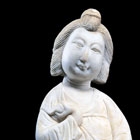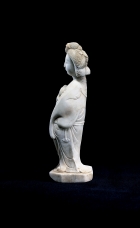J.J. Lally & Co., Oriental Art / New York City, New York
MenuPast Exhibition
Ancient Chinese Tomb Sculpture
March 22 - April 10, 2004
11.
A WHITE MARBLE FIGURE OF A COURTESAN
Late Tang/Five Dynasties Period, A.D. 9th/10th Century
the young woman with full, rounded face and delicate features set in a calm and contented expression, shown standing in a languid pose with her head tilted to one side and with her hair piled up in an elaborate coif secured with ornaments at the top and back, holding one hand up close to her chest and grasping a shawl draped loosely over her shoulders, with her other hand down by her side and completely concealed by the long sleeve of her voluminous robes which are tied with a sash around her waist and hang in pleated folds to the platform base, leaving only the toe of her right shoe uncovered, the sugary white stone of even tone throughout, showing traces of earth from burial.
Height 9 1⁄2 inches (24 cm)
The plump young courtesan in long flowing robes is a classic Tang image, which continued well into the Five Dynasties period. Compare, for example, the images of plump courtesans with similar hairstyles and long flowing robes in painted marble reliefs in the tomb of Wang Chuzhi (died A.D. 923) in Xiyanchuan, Quyang, Hebei province, published in a full excavation report entitled Wu Dai Wang Chuzhi Mu (Wang Chuzhi’s Tomb of the Five Dynasties Period), Beijing, 1998, pls. 33-57. The same marble reliefs were included in the 1999 special exhibition at the National Gallery of Art and illustrated in the catalogue The Golden Age of Chinese Archaeology, Washington, D.C., 1999, pp. 509-513, nos. 174-175.
Compare the smaller seated white marble female figure, excavated in 1988, from a Tang dynasty site at Nianliwang village, Changan county, Shaanxi province, illustrated in Wu Hua Tian Bo – Tangdai Guizu de Wuzhi Shenghuo (Daily Life of Aristocrats in Tang China), Hong Kong, 1993, no. 8, p. 49.
Compare also the white marble seated figure of a female musician playing a Chinese lute which is in the collection of Tokyo Geijutsu Daigaku (Tokyo University of Fine Arts) and has been widely published after first being shown at the International Exhibition of Chinese Art, Burlington House, London, 1935 – 36, Catalogue, pl. 630.
Two other Tang gray stone sculptures of seated female musicians have been shown in London by Eskenazi, Ltd., one of which was included in their Exhibition of Ancient Chinese Sculpture, 1978, Catalogue no. 3, from the Collection of E. Wolf.

